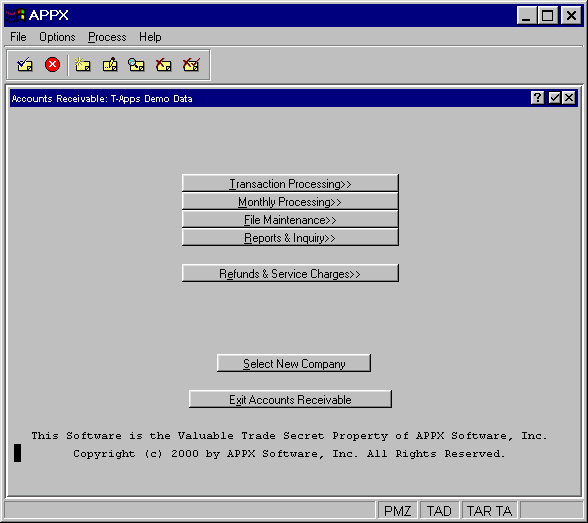


Chapter 3-1: Overview of APPX Processes



Automatic and Optional Child Invocations
A child process is the process that is invoked from another process (the parent). The invocation of a child process from the parent process can be automatic or optional..
If invocation of a child is not discretionary on the part of the application user, the child process is an automatic child. Automatic children are related to a frame, and always invoke after executing any related images. Input, output, update, job, and inquiry processes are the only process types that support automatic children. Menu, query, status, and subroutine processes do not.
If invocation of a child is discretionary on the part of the application user, the child is an optional child. Optional children are related to an image, and only invoke if a user selects the options that identify them. A menu image, for example, contains one option for each process you can select from the menu as shown in Figure 3-1-5.

Figure 3-1-5. A Menu's Optional Children
Not all types of processes can be used to invoke children. As summarized in Table 3-1-2, optional children can be invoked from menu and input processes only. Automatic children can be invoked from input, output, update, job, and inquiry processes.
You can establish selection criteria to restrict the PCF records that APPX accesses for an automatic or optional child. For example, you can use selection criteria to constrain a line item process, so only those line items that belong to the current order are accessed. In this case, the selection criteria require that the line item order number in the child process is equal to the order number in the parent process.
|
Process Type |
Optional Children? |
Automatic Children? |
|
Menu |
Yes |
|
|
Job |
|
Yes |
|
Input |
Yes |
Yes |
|
Output |
|
Yes |
|
Update |
|
Yes |
|
Query |
|
|
|
Inquiry |
|
Yes |
|
Status |
|
|
|
Subroutine |
|
|
Table 3-1-2. Combinations of Process Type/Child
Invocation Types
The way a child process is invoked from its parent establishes the boundaries of shared information between the two processes. In other words, the parent process uses the value in an Invocation Type specification to define how tightly coupled the child is to the parent. It governs the information that can be passed and shared between processes. Whether or not a specific item of information is passed or shared depends upon pass and share specifications entered in the data dictionary, or defined explicitly with statements.
There are three distinct invocation types: subprocess, related, and detached (in order from most to least tightly coupled). If you use the data dictionary default values and do not explicitly pass information with statements, the various invocation types function as follows:
· A child invoked as a subprocess shares record areas, file position information (for READNEXT operations, among others), and the contents of both permanent and temporary files with the process it was invoked from.
· A child invoked as a related process shares the contents of permanent and temporary files with the process it was invoked from. It does not share file position information, and it maintains its own record area in memory.
· A child invoked as a detached process shares only the contents of any permanent files.
Refer to Chapter 1-5: Interprocess Communication for a complete discussion of detached, related, and subprocess files and processes.
APPX Application
Design Manual (01/13/03)



© 2003 by APPX Software, Inc. All rights reserved